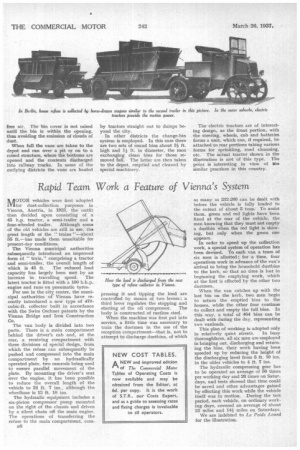Rapid Team Work a Feature of Vienna's System
Page 40

If you've noticed an error in this article please click here to report it so we can fix it.
40TOR vehicles were first adopted 1V1for dust-collection purposes in Vienna, Austria, in 1923, the outfit then decided upon consisting of a 45 h.p. tractor, a semi-trailer and a four-wheeled trailer. Although some of the old vehicles are still in use, the great length of the "trains "—about 55 ft.—has made them unsuitable for present-day conditions.
The Vienna municipal authorities subsequently introduced an improved form of "train," comprising a tractor and semi-trailer, the overall length of which is 45 ft, The reduced load capacity has largely been met by an increase in travelling speed. The latest tractor is fitted with a 100 b.h.p. engine and runs on pneumatic tyres.
For use in the city centre, the municipal authorities of Vienna have recently introduced a new type of 470cubic-ft. collector built in accordance with the Swiss Oschner patents by the Vienna Bridge and Iron Construction Co.
The van body is divided into two parts. There is a main compartment behind the driver's cab and, at the rear, a receiving compartment with three divisions of special design, from which the refuse can subsequently be pushed and compressed into the main compartment by an hydraulically operated plate, two ramrods being used to ensure parallel movement of the plate. By mounting the driver's seat over the engine, it has been possible to reduce the overall length of the vehicle to 24 ft. 7 ins., although the wheelbase is 13 ft. 10 ins.
The hydraulic equipment includes a six-piston compressor pump mounted on the right of the chassis and driven by a silent chain off the main engine. The operations of transferring the refuse to the main compartment, corn B6 pressing it and tipping the load are controlled by means of two levers ; a third lever regulates the stopping and starting of the oil compressor. The body is constructed of rustless steel.
When the machine was first put into service, a little time was necessary to train the dustmen in the use of the reception compartment—that is, not to attempt to discharge dustbins, of which as many as 232-260 can be dealt with before the vehicle is fully loaded to the extent of about 5 tons. To assist them, green and red lights have been fixed at the rear of the vehicle, the men knowing that they must not empty a dustbin when the red light is showing, but only when the green one appears.
In order to speed up the collection work, a special system of operation has been devised. To each van a team of six men is allotted; for a time, four operatives work in advance of the van's arrival to bring the household dustbins to the kerb, so that no time is lost in beginning the emptying work, which at the first is effected by the other two dustmen.
When the van catches up with the last bin on the kerb, two men begin to return the emptied bins to the houses, while the other four continue to collect and empty the full bins. In this way, a total of 464 bins can be dealt with during the day, representing two vanloads.
This plan of working is adopted only in relatively quiet streets. In busy thoroughfares, all six men are employed in bringing out, discharging and returning the bins, their work having been speeded up by reducing the height of the discharging level from 5 ft. 10 ins. in the older vehicles to 4 ft. 7 ins.
The hydraulic compressing gear has to be operated an average of 50 times per working day and 26 times on Saturdays, and tests showed that time could be saved and other advantages gained by effecting this work while the vehicle itself was in motion. During the test period, each vehicle, on ordinary working days, covered an average of about 23 miles and lft miles on Saturdays.
We are indebted to Le Poids Lourd for the illustration.




















































































